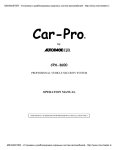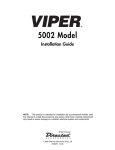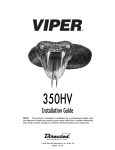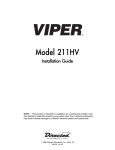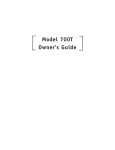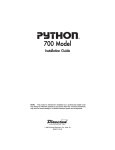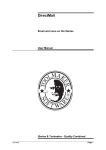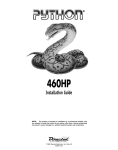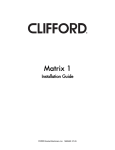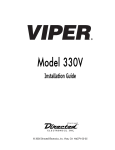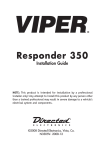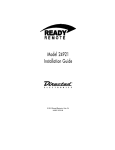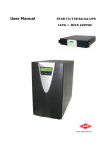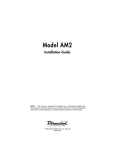Download Automate AM2 Installation guide
Transcript
MSVMASTER - - http://www.msvmaster.lv Model AM2 Installation Guide NOTE: This product is intended for installation by a professional installer only! Any attempt to install this product by any person other than a trained professional may result in severe damage to a vehicle’s electrical system and components. MSVMASTER - © 2007 Directed Electronics, Vista, CA N2102A 2007-06 - http://www.msvmaster.lv MSVMASTER - - http://www.msvmaster.lv Code Hopping®, Doubleguard®, ESP®, FailSafe®, Ghost Switch®, Learn Routine™, Nite-Lite®, Nuisance Prevention® Circuitry, NPC®, Revenger®, Silent Mode™, Soft Chirp®, Stinger®, Valet®, Vehicle Recovery System®, VRS®, and Warn Away® are all Trademarks or Registered Trademarks of Directed Electronics, Inc. www.directechs.com DirectFax 800-999-1329 Technical Support 800-753-0800 These resources are for authorized Directed Dealer use only. MSVMASTER - - http://www.msvmaster.lv MSVMASTER - - http://www.msvmaster.lv Table of Contents primary harness (H1), 12-pin connector . . . . . . . . . . . . . . . . . . . . . . . . . . . . . . . . . . . . . . . . . . .4 Peripheral Plug-In Harnesses . . . . . . . . . . . . . . . . . . . . . . . . . . . . . . . . . . . . . . . . . . . . . . . . . . . .9 Integrated LED/Valet® Switch, 2-Pin BLUE Plug . . . . . . . . . . . . . . . . . . . . . . . . . . . . . . . . .9 Super Bright LED, 2-Pin WHITE Plug . . . . . . . . . . . . . . . . . . . . . . . . . . . . . . . . . . . . . . . . .9 System Features Learn Routine . . . . . . . . . . . . . . . . . . . . . . . . . . . . . . . . . . . . . . . . . . . . . . . . . .9 System Features Menus . . . . . . . . . . . . . . . . . . . . . . . . . . . . . . . . . . . . . . . . . . . . . . . . . . . . . . .11 Feature Descriptions . . . . . . . . . . . . . . . . . . . . . . . . . . . . . . . . . . . . . . . . . . . . . . . . . . . . . . . . .11 Transmitter/Receiver Learn Routine . . . . . . . . . . . . . . . . . . . . . . . . . . . . . . . . . . . . . . . . . . . . .13 Transmitter Configurations . . . . . . . . . . . . . . . . . . . . . . . . . . . . . . . . . . . . . . . . . . . . . . . . . . . .15 Standard Configuration . . . . . . . . . . . . . . . . . . . . . . . . . . . . . . . . . . . . . . . . . . . . . . . . . . . . .15 Master Dealer Remotes . . . . . . . . . . . . . . . . . . . . . . . . . . . . . . . . . . . . . . . . . . . . . . . . . . . . . . .15 Programming Master Dealer Remotes . . . . . . . . . . . . . . . . . . . . . . . . . . . . . . . . . . . . . . . . . . . .16 Rapid Resume Logic . . . . . . . . . . . . . . . . . . . . . . . . . . . . . . . . . . . . . . . . . . . . . . . . . . . . . . . . .16 Wiring Quick Reference Guide . . . . . . . . . . . . . . . . . . . . . . . . . . . . . . . . . . . . . . . . . . . . . . . . .17 © 2007 Directed Electronics MSVMASTER - 3 - http://www.msvmaster.lv MSVMASTER - - http://www.msvmaster.lv primary harness (H1), 12-pin connector H1/1 ___ RED H1/2 ___ BLUE H1/3 ___ BLACK/WHITE-1 H1/4 ___ BLACK/WHITE H1/5 ___ GREEN/BLACK H1/6 ___ WHITE/BLACK H1/7 ___ VIOLET/BLACK H1/8 ___ BLUE/BLACK H1/9 ___ VIOLET H1/10 ___ WHITE (+/-) PARKING LIGHT FLASH OUTPUT H1/11 ___ BLACK (-) CHASSIS GROUND INPUT H1/12 ___ BROWN H1/13 ___ LT. GREEN/BLACK H1/14 ___ WHITE/BLUE H1/15 ___ YELLOW (+) SWITCHED IGNITION INPUT H1/16 ___ ORANGE (-) 500 mA GROUND-WHEN-ARMED OUTPUT H1/17 ___ BROWN/BLACK H1/18 ___ RED/WHITE (+) 12V CONSTANT POWER INPUT (-) 200 mA SECOND UNLOCK OUTPUT DOMELIGHT INPUT SUPERVISION/AUX CHNL 2 RELAY #87 DOMELIGHT OUTPUT SUPERVISION/AUX CHNL 2 RELAY #30 LOCK #30 COMMON OUTPUT LOCK #87A NORMALLY CLOSED LOCK #87 NORMALLY OPEN (INPUT) UNLOCK #30 COMMON (OUTPUT) UNLOCK #87 NORMALLY OPEN (INPUT) (-) HORN HONK OUTPUT (-) 200 mA FACTORY ALARM DISARM (-) 200 mA CHANNEL 3 VALIDITY OUTPUT UNLOCK #87A NORMALLY CLOSED (-) CHANNEL 2 OUTPUT/DOMELIGHT SUPERVISION H1/1 RED (+)12V constant power input Before connecting this wire, remove the supplied fuse. Connect to the battery positive terminal or the constant 12V supply to the ignition switch. NOTE: Always use a fuse within 12 inches of the point you obtain (+)12V. Do not use the fuse in the harness for this purpose. This fuse protects the module itself. H1/2 BLUE (-) 200 mA Second Unlock Output The H1/2 BLUE output is used for progressive unlock. A progressive unlock (default is OFF, you must turn feature 13 ON) system unlocks the driver's door when the unlock (disarm) button is pressed and unlocks the passenger doors if the unlock (disarm) button is pressed again after unlocking the driver's door. The BLUE wire outputs a low current (-) pulse on the second press of the unlock button of the transmitter. This negative unlock output is used to unlock the passenger doors. 4. MSVMASTER - © 2007 Directed Electronics - http://www.msvmaster.lv MSVMASTER - - http://www.msvmaster.lv H1/3 BLACK/WHITE-1 Domelight Supervision/Aux Channel 2 Input (pin 87) This wire determines what the output polarity of H1/4 will be. If the door pin circuit is negative, connect to chassis ground. If the door circuit is positive, connect to a fused 12V source. When feature 15 is selected to Aux Channel 2, this input will be determined by the polarity required on the output of the H1/4 wire. IMPORTANT! The H1/3 wire is not required for wiring the door locks. Depending on the type of door lock system, there may be additional wires for the Door Lock wiring that are not required. H1/4 BLACK/WHITE Domelight Supervision/Aux Channel 2 Output (pin 30) If using this output for the domelight supervision option, connect this wire directly to the domelight circuit. If using for the Aux Channel 2, connect this wire directly to wire that you decide to activate or control. The on-board relay will drive circuits up to 10 amperes. The polarity of this output is determined by the connection of the input wire H1/3 in the relay harness. NOTE: Feature 15 determines the function of this wire. Make sure to double check the feature settings if this output is not working correctly. H1/5 GREEN/BLACK Lock #30 Common (Output) The system has door lock relays on-board, and can directly interface with most electric power door lock systems drawing 15 amps or less. It can also drive aftermarket actuators directly. (Some vehicles require that an aftermarket actuator be added to the driver’s door to allow system control, see Type D wiring section in Tech Tip Document 1041). H1/6 WHITE/BLACK Lock #87A Normally Closed See H1/5. H1/7 VIOLET/BLACK Lock #87 Normally Opened (Input) See H1/5. H1/8 BLUE/BLACK Unlock #30 Common (Output) See H1/5. H1/9 VIOLET Unlock #87 Normally Open (Input) See H1/5. H1/10 WHITE (++/-) Parking Light Flash Output This wire provides a high current + or - output to flash the parking lights (+ is factory default setting). This is suitable for driving (-) light control wires in Toyota, Lexus, BMW, some Mitsubishi, some Mazda, etc. If the vehicle has a negative parking light circuit, the light flash fuse on the control module must be moved to the negative (-) setting. © 2007 Directed Electronics MSVMASTER - 5 - http://www.msvmaster.lv MSVMASTER - - http://www.msvmaster.lv H1/11 BLACK (-) Chassis Ground Connection Connect this wire to a clean, paint-free sheet metal location (driver kick panel) using a factory bolt that DOES NOT have any vehicle component grounds attached to it. A screw should only be used when in conjunction with a two-sided lock washer. Under dash brackets and door sheet metal are not acceptable ground points. It is recommended that all security components be grounded at the same location. H1/12 BROWN (-) Horn Honk Output This wire supplies a (-) 200 mA output that can be used to honk the vehicle horn. It outputs a single pulse when locking the doors with the remote, and two pulses when unlocking with the remote. This wire will also output pulses for 30 seconds when the Panic Mode is activated. If the vehicle has a (+) horn circuit, an optional relay can be used to interface with the system, as shown below. H1/13 LT. GREEN/BLACK Factory Alarm Disarm This wire sends a negative (-) 200ma pulse every time the system is unlocked/disarmed or an optional channel is activated. This can be used to pulse the disarm wire of the vehicle's factory antitheft device. Use a relay to send a (-) or (+) pulse to the disarm wire as shown in the diagrams below. note: In most instances the negative pulse output can be connected directly to the factory disarm wire. The circuit shown on the left below is provided for those instances where direct connection will not correctly function. 6. MSVMASTER - © 2007 Directed Electronics - http://www.msvmaster.lv MSVMASTER - - http://www.msvmaster.lv H1/14 WHITE/BLUE (-) Channel 3 Output This wire provides a (-) 200 mA output whenever the transmitter code controlling Channel 3 is received. This output will continue as long as that transmission is received. Use for options such as Directed’s 561T Valet® Start system, 529T or 530T power window controllers, etc. IMPORTANT! Never use this wire to drive anything but a relay or a low-current input! The transistorized output can only provide (-) 200 mA of current, and connecting directly to a solenoid, motor, or other high-current device will cause it to fail. H1/15 YELLOW (+) Switched Ignition Input Connect this wire to an ignition source. This input must show (+)12V with the key in run position and during cranking. Make sure that this wire cannot be shorted to the chassis at any point. This wire will trigger the system if the ignition is turned on before the unit is disarmed (doors unlocked with the remote). It will also honk the vehicle’s horn and flash the parking lights (if connected). © 2007 Directed Electronics MSVMASTER - 7 - http://www.msvmaster.lv MSVMASTER - - http://www.msvmaster.lv H1/16 ORANGE (-) 500mA Ground-When Armed Output This wire supplies a (-) 500mA ground as long as the system is armed. This output ceases as soon as the system is disarmed. Note: If using the H1/16 Orange wire to activate an add-on accessory such as window automation, pager or voice module a 1-Amp diode must be installed to ensure proper operation. Insert the diode as shown in the following diagram. H1/17 BROWN/BLACK Unlock #87A Normally Closed See H1/5. H1/18 RED/WHITE Channel 2/Programmable Domelight Supervision, (-) 200ma output When the system receives the transmitter code controlling Channel 2/Aux for longer than 1.5 seconds, the red/white wire will supply an output as long as the transmission continues. This is often used to operate a trunk/hatch release or other relay-driven functions. When feature 15 is selected to Aux channel 2, this output becomes a (-) 200ma domelight supervision output. IMPORTANT! Never use this wire to drive anything but a relay or a low-current input! The transistorized output can only supply 200 mA of current. Connecting directly to a solenoid, motor, or other high-current device will cause it to fail. 8. MSVMASTER - © 2007 Directed Electronics - http://www.msvmaster.lv MSVMASTER - - http://www.msvmaster.lv Peripheral Plug-In Harnesses Integrated LED/Valet® Switch, 2-Pin BLUE Plug The integrated LED/Valet® switch should be accessible from the driver’s seat. It plugs into the BLUE port on the side of the unit. Consider how the button will be used before choosing a mounting location. Check for rear clearance before drilling a 5/16-inch hole and mounting the button. The integrated LED/Valet® switch requires an 1-1/2 inches of rear clearance for mounting. Super Bright LED, 2-Pin WHITE Plug WHITE Plug LED Blue Red LED/Valet Switch BLUE Plug Valet Switch Black Grey The super bright LED part of the integrated LED/Valet® switch operates at (+) 2 volts DC and plugs into the two-pin WHITE port. Make sure the LED wires are not shorted to ground as the LED will be damaged. System Features Learn Routine The System Features Learn Routine dictates how the unit operates. It is possible to access and change any of the feature settings using the Valet®/Program switch. To enter the learn routine: © 1. Key. Turn the ignition on and then back off. 2. Choose. Within 10 seconds, press and release the Valet®/Program switch the number of times corresponding to the feature number you want to program. (See Feature Menus.) Once the Valet®/Program switch has been pressed and released the desired number of times, press it once more and hold it. After a second, the LED will flash and the horn will honk according to the feature you have accessed. 2007 Directed Electronics MSVMASTER - 9 - http://www.msvmaster.lv MSVMASTER - - http://www.msvmaster.lv 3. Transmit. The transmitter is used to select the desired setting. As shipped, the unit is configured to the LED ON/1 chirp settings. These are the default settings. Pressing the lock button will move settings back to the LED ON/1 chirp setting. The LED will light solid (stop flashing) to indicate the setting. The horn will honk once (if connected). Pressing the unlock button will change the setting to the LED OFF setting. The LED will go out indicating the change and the horn will honk twice (if connected). Features with more than two setting options, please see note below. 4. Release. The Valet®/Program switch can now be released. For example, to program the arming mode from active to passive, within 10 seconds of turning the ignition off, and press and release the Valet/Program switch once. Then press it again and hold it. The LED will flash in groups of one and the horn will honk once (if connected). While holding the Valet®/Program switch, press the unlock button. The LED will continue to flash twice. The horn will honk twice if connected. Passive arming is now programmed. If that was not the desired setting, without releasing the Valet®/Program switch, press the lock button. The LED will light solid and the horn will honk once if connected. Active arming is now programmed. Release the Valet®/Program switch after the selection has been made. You can advance from feature to feature by pressing and releasing the Valet®/Program switch the number of times necessary to get from the feature you just programmed to the feature you wish to access. For example, if you just programmed Feature 2 and you next want to program Feature 3 to off, release the Valet®/Program switch. Press and release it once to advance from Feature 2 to Feature 3. Then press it once more and hold it. The LED will flash in groups of three and the horn will honk three times (if connected) to confirm that you have accessed Feature 3. The learn routine will be exited if: ➤ The ignition is turned on. ➤ The Valet/Program switch is pressed too many times. ➤ More than 15 seconds elapses between programming steps. One long horn honk (if connected) indicates that the Learn Routine has been exited. 10. MSVMASTER - © 2007 Directed Electronics - http://www.msvmaster.lv MSVMASTER - - http://www.msvmaster.lv System Features Menus Feature Number One-chirp/LED ON Setting Two-chirp/LED OFF Setting (chirp# in ( ) for multiple options) 1 Active arming Passive(2)/Auto rearm setting(3) 2 Horn honk ON OFF(2)/OEM style(3) 3 Horn output duration 50ms 20ms(2)/30ms(3)/40ms(4) 4 Ignition lock OFF Ignition lock ON 5 Ignition unlock OFF Ignition unlock ON 6 Active locking Passive locking 7 Ignition-controlled domelight ON Ignition-controlled domelight OFF 8 Door lock pulse duration 0.8s Door lock pulse duration 3.5s(2)/0.4s(3) 9 Double pulse unlock OFF Double pulse unlock ON 10 Double pulse lock OFF Double pulse lock ON 11 Security features OFF Security features ON 12 Code Hopping ON Code Hopping OFF 13 2nd unlock ouput OFF 2nd unlock ouput ON 14 Comfort closure OFF Comfort closure ON (CC1(2) and CC2(3)) 15 Aux relay Domelight supervision Aux channel 2 Note: Factory default settings are shown in BOLD. Note: When changing features that have more then 2 options in the right column, you will use the unlock button on the remote to toggle through these options. The horn will honk the number of times to confirm the feature setting. Example:Feature 3 has 4 settings. If 40ms was the desired setting, the horn will chirp 4 times. Note: If feature 1 is selected for Passive or Auto rearm, feature 6 is not recommended for Passive locking. The system can possibly lock the end user out of their vehicle. Feature Descriptions The features of the system are described below. © 2007 Directed Electronics MSVMASTER - 11 - http://www.msvmaster.lv MSVMASTER - - http://www.msvmaster.lv 1 ACTIVE/PASSIVE/AUTO REARM ARMING: When active arming is selected, the system will only arm when the transmitter is used. When set to passive, the system will arm automatically 30 seconds after the ignition is turned off. When set to auto rearm, the system will not arm by itself when the ignition is turned off but will rearm 30 seconds after being disarmed by the remote if the ignition was never turned on indicating the vehicle was never entered. 2 HORN HONK ON/OFF/OEM: When horn honk is selected on, the system will honk the horn upon lock and unlock. When off is selected, the system will not honk upon lock and unlock. When OEM is selected, the horn will only honk upon pressing lock twice and not upon unlock. 3 HORN OUTPUT DURATION: This is the pulsed time output for the horn. On some vehicles the horn output may respond differently than others, the default is 50ms. 4 IGNITION LOCK: When selected OFF, upon turning the ignition on the doors will not lock. When selected ON, upon turning the ignition on the doors will lock. 5 IGNITION UNLOCK: When selected OFF, upon turning the ignition off the doors will not unlock. When selected ON, upon turning the ignition off the doors will unlock. 6 ACTIVE/PASSIVE LOCKING: When active locking is selected, the doors will only lock via the remote. If passive arming or auto rearm is selected from feature 1, you can choose passive locking to have the locks automatically lock upon the system arming itself. 7 IGNITION-CONTROLLED DOMELIGHT: When selected ON, the system will turn on the domelight for 30 seconds when the ignition is turned off, and also turn on upon unlock/disarm. When the feature is selected OFF, the domelight output will turn on the domelight for 30 seconds upon unlocking only. 8 DOOR LOCK PULSE DURATION: Some European vehicles, such as Mercedes-Benz and Audi, require longer lock and unlock pulses to operate the vacuum pump. Programming the system to provide 3.5 second pulses, will accommodate the door lock interface in these vehicles. Vehicles with factory comfort closure it may be necessary to shorten the pulse to 0.4 seconds. Upon locking or unlocking the doors the windows may vent or roll down in those cases. The default setting is 0.8 second door lock pulses. 9 DOUBLE PULSE UNLOCK: Defaulted OFF, but when selecting on it will program the unlock output from one to two pulses. 10 DOUBLE PULSE LOCK: Defaulted OFF, but when selected on it will program the lock output from one to two pulses. 12. MSVMASTER - © 2007 Directed Electronics - http://www.msvmaster.lv MSVMASTER - - http://www.msvmaster.lv 11 SECURITY FEATURES: When selected OFF, the (-) ground-when-armed and ignition sense trigger will not be active upon locking the vehicle. When selected ON, (-) ground-when-armed output will be active and can be used to operate a starter kill. The unit will also trigger a panic sequence if the ignition is turned on before unlocking/disarming the system. 12 CODE HOPPING ON/OFF: The system uses a mathematical formula to change its code each time the transmitter and receiver communicate. This makes the group of bits or "word" from the transmitter very long. The longer the word is, the easier it is to block its transmission to the unit. Disabling the Code Hopping® feature lets the receiver ignore the Code Hopping® part of the transmitted word. As a result, the unit may have better range with Code Hopping® off. 13 2ND UNLOCK OUTPUT OFF/ON: When selected OFF, the H1/2 blue wire has no function. This feature is defaulted off to allow the user to be able to press unlock on the (4-Button) to unlock the car no matter what state the vehicle in. When using a (3-Button) single lock/unlock button it will just toggle back and forth between lock and unlock. When selected ON, pressing unlock twice on the remote will output a negative pulse on the H 1/2 blue wire. 14 Comfort closure OFF/CC1/CC2: The system can be programmed to close the windows when the system is armed. When CC1 is selected, a 20-second output starts 200ms after the last lock pulse. When CC2 is selected, a 20-second output starts immediately after the lock pulse. NOTE: CC2 was designed for some vehicles that may panic the factory alarm when set in the CC1 setting. 15 Aux relay control (DOMELIGHT SUPERVISION/Aux Channel 2): When selected to domelight supervision and feature 7 is turned on, the dome light will turn on for 30 seconds every time the ignition is turned off and upon unlock/disarm. When selected to Aux Channel 2, the onboard domelight supervision relay is converted into a high current Aux channel 2 and in return the red/white H 1/18 wire is converted to a 200mA (-) domelight supervision output. Transmitter/Receiver Learn Routine The system comes with two transmitters that have been taught to the receiver. The receiver can store up to four different transmitter codes in memory. Use the following learn routine to add transmitters to the system or to change button assignments if desired. 1. © 2007 Directed Electronics MSVMASTER - Key. Turn the key to the ON position. 13 - http://www.msvmaster.lv MSVMASTER - - http://www.msvmaster.lv 2. Choose. Within 10 seconds, press and release the Valet/program switch the number of times corresponding to the desired channel listed below. Once you have selected the channel, press the switch once more and HOLD it. The LED will flash and the horn will honk ( if connected) to confirm the selected channel. Do not release the Valet/program switch. 3. Transmit. While holding the Valet/Program button, press the button from the transmitter that you wish to assign to the selected channel. The unit will chirp indicating successful programming. It is not possible to teach a transmitter button to the system more than once. 4. Release. Once the code is learned, the Valet/Program button can be released. Channel Number Function Wire Color 1 Auto Learn 2 Lock/Arm only 3 Unlock/Disarm only 4 Channel 2 RED/WHITE 5 Channel 3 WHITE/BLUE 6 Arm/Disarm/Panic 7 Panic Only 8 Delete all transmitters **NOTE: For Auto Learn Configurations, see Transmitter Configurations section of this guide. Channel #8: If any button from a known transmitter is programmed to Channel 8, all transmitters will be erased from memory and the system features will revert to the default settings. This is useful in cases where the one of the customer's transmitters is lost or stolen. This will erase any lost or stolen transmitters from the system's memory. It can also be used to start from scratch if the transmitter buttons or features were programmed incorrectly. To exit the learn routine: One long horn honk indicates that Learn Routine has been exited. ➤ ➤ ➤ 14. Ignition is turned off. Valet/Program button is pressed too many times. More than 15 seconds elapse between steps. MSVMASTER - © 2007 Directed Electronics - http://www.msvmaster.lv MSVMASTER - - http://www.msvmaster.lv Transmitter Configurations The transmitters can be programmed with the standard or single button arm/disarm configurations by using the Auto Learn functions in the Transmitter/Receiver Learn Routine. Standard Configuration A remote that uses the standard configuration operates similarly to many factory keyless entry remotes. A standard configuration transmitter allows lock/arm, unlock/disarm, and Panic Mode activation with separate buttons. When programmed for standard configuration using the Channel 1 Auto-learn configuration, the transmitter buttons are assigned to the following functions: and operates Lock/Arm only operates Unlock/Disarm only operates Channel 2 and Silent Mode operates Panic only operate Channel 3 Master Dealer Remotes A master dealer remote can be programmed into the system for demonstration purposes. Generally, each salesman would carry a remote that would operate all the cars on the lot equipped with this system. The dealer remotes(part# 465D) are binary transmitters that are detuned slightly in order to limit transmitting range. The dealer remote can be taught to the system by following the Transmitter Learn Routine. When installing the system, it is possible to preset all of the operation settings using the master dealer remote. However, when the system is operated using the master dealer remote, a special set of dealer default settings are followed. The dealer default settings are used to ensure that every vehicle equipped with this system is protected at all times. Only the settings listed below are affected. When using a master dealer remote, the system operates as follows: ➤ ➤ ➤ ➤ © Passive arming Passive locking Panic, Valet, and passive arming bypass are disabled Security features on 2007 Directed Electronics MSVMASTER - 15 - http://www.msvmaster.lv MSVMASTER - - http://www.msvmaster.lv Programming Master Dealer Remotes Follow the program instructions above and use the Directed part number 465D(master dealer remote). The only programming channels in master dealer mode are channel 1 and 8. CHANNEL NUMER FUNCTION 1 Auto Learn 8 Delete all transmitters Rapid Resume Logic Rapid Resume Logic ensures that the when the system is powered up it will return to the same state it was in when power is disconnected. For a full description of Rapid Resume Logic refer to the owner's manual. 16. MSVMASTER - © 2007 Directed Electronics - http://www.msvmaster.lv © MSVMASTER - 2007 Directed Electronics LIGHT FLASH JUMPER Valet/LED Switch VIOLET Unlock #87 Normally Open (Input) RED/WHITE (-) Channel output 2 / Domelight supervision BLUE/BLACK Unlock #30 Common Output BROWN/BLACK Unlock #87A Normally Closed VIOLET/BLACK Lock #87 Normally Open (Input) ORANGE (-) 500 mA Ground-When-Armed Output WHITE/BLACK Lock #87A Normally Closed YELLOW (+) Switched Ignition Input GREEN/BLACK Lock #30 Common Output WHITE/BLUE (-) 200 mA Channel 3 Validity Output BLACK/WHITE Output of Domelight Supervision/Aux Chnl 2 Relay #30 LT. GREEN/BLACK Factory Alarm Disarm (-200ma) output BLACK/WHITE-1 Input to Domelight Supervision/Aux Channel 2 Relay #87 BROWN (-) Horn Honk Output BLUE (-200mA) 2nd Unlock Output BLACK (-) Chassis Ground Input RED (+) 12V Constant Power Input WHITE (+/-) Light Flash Output MSVMASTER - http://www.msvmaster.lv Wiring Quick Reference Guide - http://www.msvmaster.lv 17

















